Introducing the new
Vi7000 and Vi5000
The control you love with the power you need
The latest Soundcraft Vi5000 and Vi7000 digital mixing consoles deliver the best Vi sound ever, bringing optional 96kHz processing, upgraded channel counts and even more reliable hardware to live sound's most popular mix interface.
The latest Vistonics™ & FaderGlow™ interface
Up to 128 inputs and 32 mono/stereo busses
Enhanced audio processing with 96kHz sample rate option
Powerful new features including BSS DPR901ii™ Dynamic EQ
New Local Rack hardware for 384 I/O channels
128 channel record interface via MADI or Dante®
Mix live with UA™ plug-ins (via Realtime Rack)
Huge connectivity options: Dante®, Rocknet®, Ethersound®, Cobranet®, MADI and more
Vistonics.
Live sound mixing with vision.
Our patented Vistonics was designed from a simple start point - create the most intuitive digital mix interface available. Rather than arranging controls around or adjacent to a flat TFT screen, a system that requires constant hand and eye co-ordination and mental mapping, Vistonics simplifies the process and puts the rotary encoders and switches right on the touch screen.
With graphics behind the controls that change depending on the function, the operator is left in no doubt as to what parameter is being adjusted.
With the display and relevant controls combined in one area, the operator is immediately presented with a simple, clear mix system that streamlines workflow and enhances the creative process.
Each Vistonics interface controls eight input channels and comprises a touch screen with 16 rotary encoders and 16 switches. A simple touch in the desired part of the on-screen channel strip is all it takes to access channel functions including routing, input gain, digital gain trim, delay, high and low pass filters, 4-band fully parametric EQ, compressor, limiter, gate, de-esser and pan, with immediate access to a sophisticated visual status display and straightforward controls.
In addition, a dedicated Vistonics II interface is provided for output processing control, and also functions as a complete meter overview display for all 128 inputs and 32 busses, as a snapshot cue list display, and as a display for diagnostics information.
FaderGlow.
Don't get lost in the dark.
In the heat of the moment, with the faders flying, fader layers can cause all kinds of headaches. Soundcraft® FaderGlow solves the problem associated with multiple fader layers. At a single glance, illuminated-fader-tracks-in-colours that match those on the Vistonics™ display show immediately what function a fader is controlling.
Within the output section of the console, the bank of 8 faders can be assigned to provide master control of matrix outputs, VCA groups and graphic EQ control. FaderGlow applies cyan, blue and red illumination respectively to the fader track, enabling the operator to see the different output types immediately – even before reading the text labels for each fader.
When controlling inputs, no illumination is applied to the motorised faders. But when the Aux, Group or Matrix bus master is soloed with the Follow Solo function switched on, the fader becomes a ‘contributor’ for the soloed bus, lighting up in orange, green or blue accordingly. Furthermore, custom fader pages can be created to contain, for instance, 10 drum faders grouped on a single VCA master, which would glow in blue.
A console focussed on the operator.
Vistonics and FaderGlow are just part of what makes Vi Series digital consoles such intuitive and creative tools. Every aspect of the control surface, mechanical and operational, has been engineered around the operator to provide an unimpeded workflow and a more creative mix.
By optimising the density of faders and controls on the operating surface, the engineer is able to reach all critical areas of the console comfortably from a central point, without straining or leaning over.
The angle of the touch screens ensures that the engineer can always view display data clearly during the show. The brightness and contrast of the displays, and the illumination of the control surface itself, are designed to minimise strain on the eye.
User-configurable fader layers allow an engineer to map out channels on any of 5 user layers so that a combination of different inputs can be placed on one layer. This allows, for example, the main vocalist mics to be programmed to appear in the same location on every layer, or other essential channels to be brought closer to a central operating position. At a festival, each engineer can quickly assign to the surface only those channels needed for their band.
Output fader layers can also be customised, for example, stereo aux masters can be placed alongside VCAs or matrix masters for faster access to the most used outputs..
The fastest, most intuitive channel strip in the business

No button pushes or page scrolling - just one touch of the Vistonics screen gives you instant access to every aspect of the Vi channel strip. Each Vistonics screen functions both as a permanent overview of all the current settings (8 channels per screen), and as the access point for immediate hands-on control of any of those settings. Simply touching the screen in one of the six vertically stacked touch zones immediately opens out that part of the strip onto the 16 real knobs and switches mounted directly on the lower part of the display, allowing immediate, tactile, analogue-style control. The colour-coded context-sensitive graphics around the knobs make it abundantly clear which type of function is being adjusted, and a clear white highlight is a constant reminder of which channel is being controlled. Touching the screen again is all it takes to move to another area of the channel strip, or to close the control area.
Touch & Control
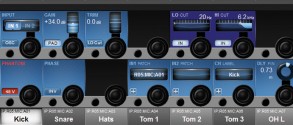
The blue input stage and routing screen allows adjustment of input delay, mic gain, digital trim, high and low-pass filter frequency, channel patching, channel naming and stereo pairing.
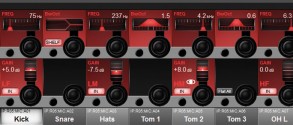
The four-band fully parametric EQ is graphically displayed with the settings for boost/cut, frequency and Q (bandwidth), with the main screen showing the composite EQ curve. Frequency is displayed in a similar style to a radio tuner scale for easy assimilation, and the HF and LF bands can be switched to shelving EQ. A separate BSS Dynamic EQ section is available via the insert point function.
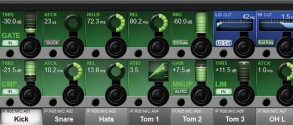
The dynamics section controls a Noise Gate with attack, hold and release, and a key facility with filtering. The Gate can be replaced with a De-Esser function or can be converted to use as an externally triggered ducker. Working in series with the Gate, the full-function Compressor maps gain reduction metering onto the LED meter in the fader area, with full control of threshold, ratio and release with an independent Limiter section and overall gain makeup.
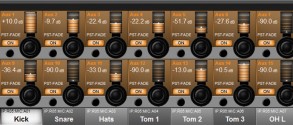
Two areas of the channel strip allow access to bus send controls, arranged in two banks of 16. The ALL BUSSES mode allows assignment of each of the busses as an Aux, Group, or Matrix output, with additional stereo pairing controls if busses are required as stereo sends.
_Sel-w293h125.jpg)
Subsequently within each channel strip setup, bus sends can be switched on or off with level control, or switched pre or post fader, with a global mode allowing pre or post EQ feeds.
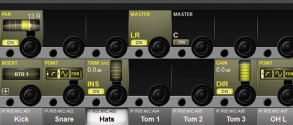
The final section of the channel strip controls the Pan, Insert and Direct out functions, with assignable LR and C, or LCR panning modes. Inserts can be switched pre or post-EQ/dynamics or post-fade, with the Direct output send assignable to pre-filters, pre-EQ/dynamics, post EQ/dynamics and post-fade points. The insert point allows a choice of internal Lexicon FX, BSS DPR901ii™ Dynamic EQ or external Plug-Ins from a Soundcraft® Realtime Rack.
Radio mic status monitoring
for AKG™ and Shure™

You know what it’s like. The radio mics check out fine on the RF Tech’s laptop, but that’s before the talent walks onto the stage. Reception black spots, drained batteries, accidental mutes – anything can happen once the show gets underway.
Vi makes the engineer’s life easier, letting you monitor the status of any compatible AKG or Shure radio mic directly from the Soundcraft® Vi Series console surface, courtesy of VM2 (Vistonics Microphone Monitoring). With realtime visual displays of battery life, RF status, mic muting and internal clipping, you’ll be able to see a problem long before you hear it, right there on the relevant channel strip – with expanded information instantly available just by touching the Vistonics screen.
Enhanced monitor mix features
Vi consoles are equally designed for FOH and monitor mixing, with powerful features that makes it easy to mix large scale monitoring applications or deal with the compromises necessitated by mixing FOH and monitors from one surface.

All busses to stereo
All busses can be turned to stereo without tying up two busses, providing a massive 32 stereo mix capability ? perfect for mixing large monitor applications.

4 Aux send points
With a total of 4 aux send pick-off points from the input channel for each send, monitor mix engineers have the flexibility to tailor mixes more closely to performers? requirements. Sends can be pre-EQ, pre-compressor, pre-fade or post-fade on a per channel/per bus basis.

Aux VCA mode
VCA master faders can control the aux sends of their member channels on a per mix basis, with FaderGlow illuminating in white to indicate the VCA?s operation on the current mix. Monitor engineers can retain control of important global elements such as ambient mics while also having a monitor mix selected and adjusting groups of sources within the current mix using the Aux-VCAs. Blue illumination of FaderGlow indicates that the VCA is controlling the global channel level to all mixes.
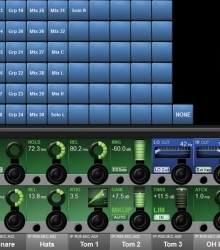
Auto-increase of ambient mic levels in monitor mixes between songs
Performers using in-ear monitors want to hear the audience between songs? No problem. Vi consoles have the facility to externally control the Gate or Ducking processing from a bus in the console, so all you have to do is insert a ducker on an ambient mic with an external source of the LR bus or a spare bus, and the audience level increases automatically when the performers stop playing.
World-class effects and dynamics inside
Minimising the need for outboard processing gear, Vi5000 and Vi7000 put class-leading effects and dynamics from Lexicon and BSS directly within the console. Via the Vistonics interface and FaderGlow surface, Vi provides the perfect vehicle for effects control. No wonder many engineers are claiming that Vi is the only console they would use without any additional processing equipment.
The BSS DPR901ii was an industry-standard analogue dynamic equaliser used the world over for its capability as a powerful tool for awkward corrective tasks. A unique feature of the DPR901ii was the under/over threshold switch on each band, enabling the equaliser to react in either cut or boost mode to correct problems that occur only on loud or only on quiet signals.
The Vi5000 and Vi7000 bring the world’s first accurately modelled version of the original analogue unit, to the digital domain. 16 instances of this classic processor are available via the console’s insert pool to use as required.
BSS DPR901ii and Graphic EQ
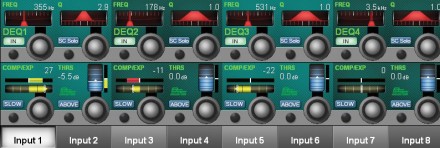
Lexicon Effects
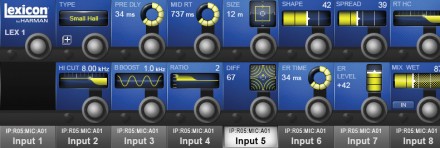
Mix live with UA plug-ins

Answering the call for high-fidelity ‘off-the-record’ studio processing at live events, Soundcraft® Realtime Rack unlocks a world of creative possiblilities by placing Universal Audio’s acclaimed analogue audio processing emulations and award-winning UAD Plug-Ins seamlessly within your mix environment.
Realtime Rack software gives Vi console operators all the control they need to insert UAD Plug-Ins on individual channels, auxiliary channels, and master busses – just as easily as real hardware. Control of the plug-ins is via an intuitive and responsive external touchscreen interface. A comprehensive snapshot system allows total recall of all plug-ins and their settings, while tight network integration with the Vi Series ensures that all settings of the application are stored inside the console.
Software control - rapid configuration and powerful automation.
Whatever the show, the Vi operating system is designed to dramatically reduce set up time and protect every critical setting with enhanced data security in the event of power failure.

Copy/Paste channel, bus and FX settings
Dedicated Copy and Paste buttons on the surface allow the settings of any channel, bus or FX section to be copied and pasted, dramatically cutting down the set up time.

Settings Library
Along with a useful library of EQ and Dynamics settings, operators can store their own settings in the console or to a USB memory stick, making initial set up and transition between shows even easier.

Sophisticated Cue List Management
Allows changes to be applied to multiple cues and recall scope to be set per snapshot.

Copy/Paste processing elements
Operators can drill down to copy and paste even single processing elements, and the last paste operation can always be quickly reversed with an UNDO function.

Advanced events integration
Cues can trigger or be triggered by MIDI or GPIO events, including MIDI timecode. Harman’s HiQnet Venue recall function is tightly integrated within the Cue List.
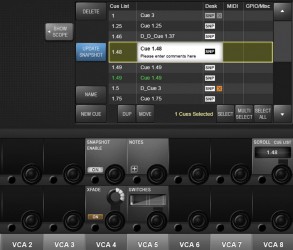
Snapshot crossfades
Snapshot recalls can use crossfades to transition smoothly from one setting to the next.

Offline Editing
Virtual Vi set-up
Saving prep time and letting you set up your shows offline, Virtual Vi software is the fast and easy way to create scenes and store to USB ready for loading directly into the Vi5000 or Vi7000 console. The Virtual Vi software also allows direct online control of the Local Rack?s DSP engine, in the unlikely event that the control surface should fail.
Online Mixing
ViSi remote control via iPad
The ViSi remote app gives you control over all major mixing functions, empowering operators to mix from anywhere in the venue. Check the FOH from audience locations, or adjust monitor mixes direct from the performers? positions on the stage.


New Local Rack - more I/O, more connections, more power to you
The latest incarnation of the Local Rack boosts I/O up to 384 and is loaded with additional card slots to allow simultaneous use with two Stageboxes, 2 recording cards and the Realtime Rack MADI interface.Various operating modes are available using a combination of DSP cards - 128 inputs/32 stereo busses @ 48kHz (5 DSP cards)- 64 inputs/32 stereo busses @ 96kHz (8 DSP cards)
The local rack has 16 analogue line inputs, 3 analogue mic/line inputs, a talkback mic input (mounted on the control surface) and 8 pairs of AES/EBU inputs. Outputs include 16 analogue line, 8 pairs of AES/EBU, 3 LCR local monitor A line, 2 LR local monitor B line and TB line.
Vi Stagebox - high-density, 64 mic in/32 line out, configurable I/O modules
The standard Vi stagebox houses 64 analogue mic/line inputs and 32 analogue line outputs, with 48V phantom power and a 100Hz HPF before the A-D converters. Mic amp gain can be controlled remotely from the control surface. Optional AES/EBU inputs and outputs are available for the stagebox in sections of 8, as are optional cards for a wide variety of audio interface standards including Dante, Blulink, Cobranet, Aviom A-Net16 and Ethersound.

